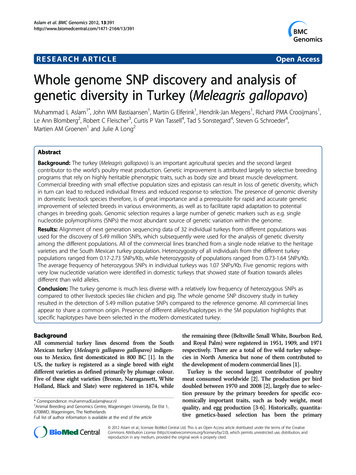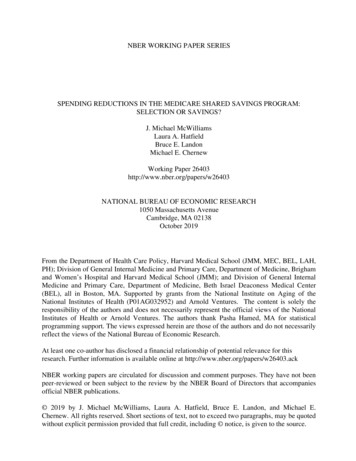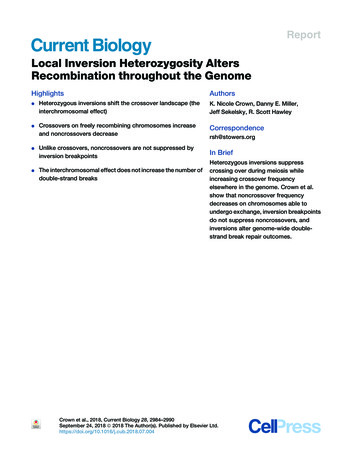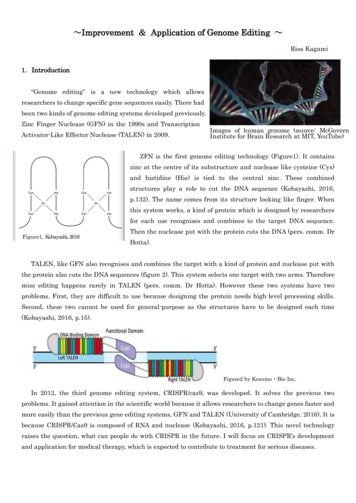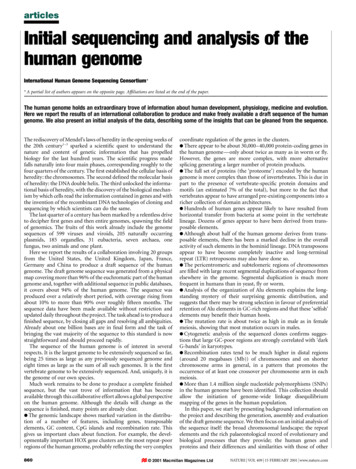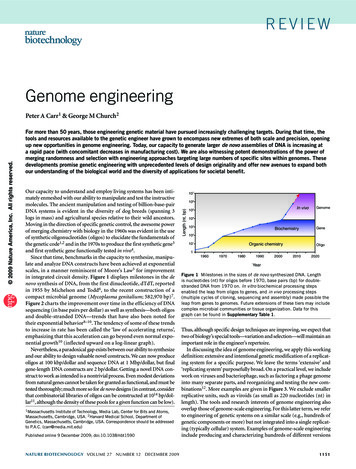
Transcription
reviewGenome engineeringFor more than 50 years, those engineering genetic material have pursued increasingly challenging targets. During that time, thetools and resources available to the genetic engineer have grown to encompass new extremes of both scale and precision, openingup new opportunities in genome engineering. Today, our capacity to generate larger de novo assemblies of DNA is increasing ata rapid pace (with concomitant decreases in manufacturing cost). We are also witnessing potent demonstrations of the power ofmerging randomness and selection with engineering approaches targeting large numbers of specific sites within genomes. Thesedevelopments promise genetic engineering with unprecedented levels of design originality and offer new avenues to expand bothour understanding of the biological world and the diversity of applications for societal benefit.Our capacity to understand and employ living systems has been intimately enmeshed with our ability to manipulate and test the instructivemolecules. The ancient manipulation and testing of billion-base-pairDNA systems is evident in the diversity of dog breeds (spanning 3logs in mass) and agricultural species relative to their wild ancestors.Moving in the direction of specific genetic control, the awesome powerof merging chemistry with biology in the 1960s was evident in the useof synthetic oligonucleotides (oligos) to elucidate the fundamentals ofthe genetic code1,2 and in the 1970s to produce the first synthetic gene3and first synthetic gene functionally tested in vivo4.Since that time, benchmarks in the capacity to synthesize, manipulate and analyze DNA constructs have been achieved at exponentialscales, in a manner reminiscent of Moore’s Law5 for improvementin integrated circuit density. Figure 1 displays milestones in the denovo synthesis of DNA, from the first dinucleotide, dTdT, reportedin 1955 by Michelson and Todd6, to the recent construction of acompact microbial genome (Mycoplasma genitalium; 582,970 bp)7.Figure 2 charts the improvement over time in the efficiency of DNAsequencing (in base pairs per dollar) as well as synthesis—both oligosand double-stranded DNA—trends that have also been noted fortheir exponential behavior8–10. The tendency of some of these trendsto increase in rate has been called the ‘law of accelerating returns’,emphasizing that this acceleration can go beyond even normal exponential growth10 (inflected upward on a log-linear graph).Nevertheless, a paradoxical gap exists between our ability to synthesizeand our ability to design valuable novel constructs. We can now produceoligos at 100 kbp/dollar and sequence DNA at 1 Mbp/dollar, but finalgene-length DNA constructs are 2 bp/dollar. Getting a novel DNA construct to work as intended is a nontrivial process. Even modest deviationsfrom natural genes cannot be taken for granted as functional, and must betested thoroughly; much more so for de novo designs (in contrast, considerthat combinatorial libraries of oligos can be constructed at 1014 bp/dollar11, although the density of these pools for a given function can be low).1MassachusettsInstitute of Technology, Media Lab, Center for Bits and Atoms,Massachusetts, Cambridge, USA. 2Harvard Medical School, Department ofGenetics, Massachusetts, Cambridge, USA. Correspondence should be addressedto P.A.C. (carr@media.mit.edu)Published online 9 December 2009; doi:10.1038/nbt1590nature biotechnology volume 27 number 12 december 2009107106Length (nt, bp) 2009 Nature America, Inc. All rights reserved.Peter A Carr1 & George M Church2In vivo105Genome104103BiochemistryGene102101Organic ure 1 Milestones in the sizes of de novo synthesized DNA. Lengthis nucleotides (nt) for oligos before 1970, base pairs (bp) for doublestranded DNA from 1970 on. In vitro biochemical processing stepsenabled the leap from oligos to genes, and in vivo processing steps(multiple cycles of cloning, sequencing and assembly) made possible theleap from genes to genomes. Future extensions of these tiers may includecomplex microbial communities or tissue organization. Data for thisgraph can be found in Supplementary Table 1.Thus, although specific design techniques are improving, we expect thattwo of biology’s special tools—variation and selection—will maintain animportant role in the engineer’s repertoire.In discussing the idea of genome engineering, we apply this workingdefinition: extensive and intentional genetic modification of a replicating system for a specific purpose. We leave the terms ‘extensive’ and‘replicating system’ purposefully broad. On a practical level, we includework on viruses and bacteriophage, such as factoring a phage genomeinto many separate parts, and reorganizing and testing the new combinations12. More examples are given in Figure 3. We exclude smallerreplicative units, such as viroids (as small as 220 nucleotides (nt) inlength). The tools and research interests of genome engineering alsooverlap those of genome-scale engineering. For this latter term, we referto engineering of genetic systems on a similar scale (e.g., hundreds ofgenetic components or more) but not integrated into a single replicating (typically cellular) system. Examples of genome-scale engineeringinclude producing and characterizing hundreds of different versions1151
r e v ie wtechnology and the availability of that new technology encourages moreambitious pursuits. So why do we build genetic systems? Put another way,if you could design and build a genome, what would you want to make?bp (or nt) per 107106dsDNA105Oligos104Sequencing10310210110 110 210 31980198519901995200020052010 2009 Nature America, Inc. All rights reserved.YearFigure 2 Efficiency trends in synthesis and sequencing over the past 30 years(base pairs per dollar). Double-stranded DNA synthesis (‘gene synthesis’) whileimproving rapidly, seems to lag behind the other two trends. The acceleratedimprovement in sequencing and oligo synthesis this past decade has beenpredicated on new miniaturization technologies (next-generation sequencingand microarray synthesis, respectively) to where the critical events take placeon surface features measured in µm2. These transitions in technology arenoted by a change to a darker line color. Commercial gene synthesis relies onboth oligo synthesis (building blocks) and sequencing (verification and errorcontrol) but has yet to take effective advantage of these miniaturized formats.Some proofs of principle have been demonstrated41,51,113. Data for this graphare detailed in Supplementary Table 2.of a gene in vitro, or saturating a genome with single-gene knockouts(thousands of separate strains each with one modification)13,14.Genetic engineering as applied over the past several decades has mostoften employed small numbers of specific components (e.g., a single promoter and ribosome binding site coupled to a protein-encoding gene).Over the past decade, advanced designs have been engineered using largernumbers of components and with more complex interdependenciesbetween them (see ref. 15). Several examples discussed below refer to current work at these scales (e.g., a dozen components), which in turn pointthe way toward future designs that may approach the genome scale.Thus, genome engineering is genetic engineering applied to genomes(or at least large portions thereof). The tools used for this purpose areoften those developed for smaller-scale genetic engineering, and appliedin high-throughput fashion. In addition, genome engineering requiresnew technology specifically suited to that scale. For example, de novo construction of DNA molecules of up to a few thousand base pairs has reliedon organic chemical and biochemical procedures. To generate an entiremicrobial genome, however, requires new methods for combining thosesmaller synthetic pieces (as detailed in ref. 7).Genome engineering is in its infancy. The new techniques that haveenabled initial work are modest compared with the needs for moretools at all stages: design, DNA construction and manipulation, implementation and testing, and debugging. Similarly, although potentialapplications are enticing, they are largely unproven at this point intime. As we discuss both these ideas and current progress, we begin withthe motivations for expanding current gene and gene systems work tothe genome scale, along with some goals that can only be achieved bydramatic engineering (or reengineering) of genomes.Motivations for genome engineeringWhat are the factors that will continue driving DNA engineering towardincreasingly larger and more complex designs? There is interplay betweenmotivating applications and the technical advances, which enable largerscales while reducing costs. The pursuit of challenging goals leads to new1152Build to understand. The Richard Feynman quote “what I cannot createI do not understand”16 is a favorite among synthetic biologists—and forgood reason. Endy17 has pointed out that for some, synthetic biology isthe pursuit of comprehending biological systems by trying to engineerthem. (And we defer to that reference for greater exposition on the term‘synthetic biology’.) Much of the history of genetic engineering has beenfor the sake of understanding the molecular workings of life, frequentlyat the level of small numbers of parts (e.g., putting the coding sequencefor a protein in a new genetic context such as a plasmid for easy manipulation and study). The complexity of such designs is increasing15,18. Forexample, genetic circuits recently have been constructed to produce pattern formation in microbial communities19—a model system for studyingthe basic principles influencing developmental patterns in higher organisms. Furthermore, a central goal of the M. genitalium genome synthesishas been to produce a construction technology to examine minimal genesets required for life20.Build for production. Living systems produce a staggering array of products tailored to human needs, including foodstuffs, materials and clothing.Recent years have seen substantial progress in metabolic engineering ofmicrobes—combining, modifying and tuning many genes from different organisms for the sake of producing medicines21 and biofuels22. Atthe genome level, there is much interest in engineering a cellular ‘chassis’for the optimal performance of such metabolic systems, involving largenumbers of modifications to a microbial genome.Build for protection. Genetic systems have also been designed to harnessmicrobes as biosensors for various types of threats23,24 and bioremediation25. Designs are currently in development for systems that allowmicrobes to hunt and destroy cancer cells26,27 and instruct one’s owncells to minimize the risk of septic shock28. An example of genome-wideengineering in this area would be the production of organisms withfundamentally altered codon usage—‘orthogonal’ genomes incapableof correctly translating genetic messages from other organisms and viceversa. At the scale of microbial genomes, this feature could prevent anengineered laboratory strain from using acquired genes to improve itsfitness (e.g., antibiotic resistance genes) and from donating its speciallyengineered features to wild organisms. Plant genomes (e.g., crops) withthis feature would be resistant to many wild pathogens (and uniquelysusceptible to designed ‘watchdog’ pathogens). They would also be incapable of outcrossing with wild strains or conventional crops.Build to creatively explore. An excellent array of explorations canbe found at the website of the International Genetically EngineeredMachines (iGEM) competition (http://www.igem.org/). These projects stand out as the accomplishments of interdisciplinary teams ofundergraduates, operating in a time frame (months) conventionallyconsidered brief for these types of efforts. There are too many intriguing applications to list here, but they include: (i) programming cellsto communicate their growth state by emitting different odors; (ii)employing microbes as a photographic print medium; and (iii) manyexamples of genetically encoded logic and computation. Although theindividual projects often fall into one or more of the above categoriesof understanding, production or protection, the entire undertakingserves as an experiment in the education and motivation of a newgeneration of synthetic biologists. In doing so, the students seize theopportunity to explore such questions as, How can I program a cell?volume 27 number 12 december 2009 nature biotechnology
r e v ie wabcFull synthesisMinimizationGenome fusionTransformSynechocystissp. PCC6803(3,573 kb)AssembleE. coli K-12MDS12, 41, 42, 43JCVI-1.1590 kbSyntheticM. genitaliumgenome in yeastBuilt for easy redesignsdEliminate unstableDNA elementsGene tools in one,metabolism in the otherefRefactoring 2009 Nature America, Inc. All rights reserved.BEST7613(7,700 kb)Bacillus subtilis168BEST7003( 4,215 kb)MAGEIn vitroDiversegenomesATPAmino acidsEnergy regenerationAminoacylationContinuallyevolving cellpopulationstRNASythesized PTranscriptionATPGTPCTPUTPSynthetic DNARedefine connections formodule independenceMany small changes formetabolic optimizationor new genetic ation factor (IF, EF, RF, RRF)Synthetic subsets ofliving systemFigure 3 Examples of engineering at the genome scale. (a) Gibson et al.61 constructed the first all-synthetic microbial genome from commercially producedDNA cassettes. (b) Posfai et al.76 deleted many large segments of the E. coli genome to eliminate unstable DNA elements. (c) Itaya et al.66 transferred themajority of one (archaeal) genome into another (prokaryote) genome. (d) Chan et al.12 decomposed the T7 bacteriophage genome into many reconfigurablemodules. (e) Wang et al.38 demonstrated a technique for making large numbers of targeted changes to a genome. (f) Shimizu et al.114 developed a purifiedtranslation system useful for in vitro prototyping of genetic functions without requiring moving genes into living cells. Note that manipulations of large DNAsegments 100 kilobase pairs in a, b and c relied heavily on in vivo recombination-based techniques.In partnership with the Registry of Standard Biological Parts29,30 thiswork also helps tackle the question of how effectively biological systems can be engineered with composed, standardized and characterized genetic components. Wrestling with these questions is essential ifwe are to consider designing genetic systems the size of genomes.Regardless of purpose, most projects in gene and genome engineeringshare a common set of tools and overall organization principles. In considering the accomplishments, challenges and opportunities of genome engineering, we examine four basic phases of an engineering project, appliedhere to genomes and other complex genetic systems: design, construction,implementation and/or testing and debugging (troubleshooting).The design of genetic systemsAlthough Figure 1 emphasizes benchmarks achieved in genetic construct size, an even more significant focus should be on engineeredfunction. Figure 4 compares the scale of a genetic engineering project (x-axis, in base pairs) to the proportion of that scale that wasdesigned de novo (Fig. 4a) and the number of ‘design units’ manipulated (Fig. 4b). No one or two metrics are expected to unify such abroad range of designs and investigations. And although a portionof them can be said to have maximized some metric as a goal (genesdeleted, proportion designed, degree of reorganization or synthesisscale), many also have no such goal in mind. Degree of difficulty, thenature biotechnology volume 27 number 12 december 2009nature of the specific functions, complexity of new configurationsand number of steps in an assembly hierarchy are certainly amongthe terms worthy of consideration.Nevertheless, we see these projects falling into three broad categoriesof genetic design:1. Design of small protein folds (up to 100% new sequence) and design ofenzymatic activity (modifying scaffolds to 10–20% new sequence).2. Design of genetic devices using naturally derived parts. These tend todisplay little de novo designed sequence; instead, new functions arederived from new configurations of existing parts. These have beenwell reviewed recently15,18.3. Manipulation of genomes by constructing, deleting and to someextent reorganizing components. These tend to be proof-of-principle reports pushing the limits of scale—often asking, How muchof this can the cell tolerate?—but not of design. This statement isnot a criticism, but an observation that genome engineering is inits infancy.Figures 1, 2 and 4 together also illustrate an underlying principle: justas current DNA sequencing capacity dwarfs DNA synthesis capacity,1153
r e v ie wGenesProportion modified1Design/assembly unitsGenomesaDe novo designDeletionOther0.10.010.001 2009 Nature America, Inc. All rights reserved.Gene systemsb100101102103104105106107Design scale (bp)Figure 4 Current projects in genetic engineering exhibit a trade-offbetween the scale that can be manipulated and the scale at which onecan effectively design. Projects are plotted according to (a) proportionmodified or (b) number of design or assembly units. Symbols forconstructs produced by de novo DNA synthesis are outlined in black.At the largest scales, the extent of modification has been essentiallythe manipulation of large natural DNA segments (synthesis, deletion,repositioning or cloning). However, the techniques developed to performthese operations set the stage for unprecedented new engineering efforts.Data for this graph are given in detail in Supplementary Table 3.so DNA synthesis dwarfs current capacity for functional design anddebugging. If the scale of available synthesis can be considered the sizeof the canvas on which we may paint, the available choices of brushesand colors are still rather modest.The recent accomplishment by Gibson et al.7 at the J. Craig VenterInstitute (JCVI; Rockville, MD, USA) illustrates the cutting edge ofthe field. The synthesis and assembly of a 582-kb pair M. genitaliumgenome exceeded by tenfold the size of any previously published denovo DNA construct (but did not reduce the cost per base pair). Theextent to which this genome was reengineered, however, was small,primarily a handful of DNA watermarks—intended to show that theconstruct truly is synthetic. And even with these slight changes, gettingthe product to function proved challenging. Nevertheless, the choiceof minimal modification seems especially prudent as the JCVI groupseeks to ‘boot’ the genomic software in a fully operational cytoplasmand debug the ensuing design/assembly process. A failure to run thegenetic operating system at this stage does not distinguish betweenproblems with design and problems with the general production and‘booting’ methods (see below). As this assembly technology becomesmore robust, putting such synthetic capacity into the hands of geneticengineers will generate enticing new opportunities for design.Standards, parts and design frameworks. In recent years, those in thesynthetic biology community have championed the need for a standardized system of genetic parts, with the hopes of enabling sophisticatedgenetic systems design17,21,31–35. A comparison is drawn with progressmade last century in electronic design: standardization of parts, such astransistors and resistors, allowed mass production, generalized designand abstraction hierarchies. Such a hierarchy builds from the bottom1154up, so that at each level of abstraction a specialist may take advantageof foundational work from more fundamental levels. One engineermay design single parts, the next a device based on such parts and athird ‘software’ using such devices. Integration of an advanced designframework based on this idea requires specialists at each level, as wellas generalists broadly versed in the overall design system36.In the initial stages of synthetic biology, design has been closelylinked to physical assembly. For example with BioBricks—the firstmajor standard implemented—assembly is kept general and independent of specific parts through the use of a restriction-ligationscheme. Although this places some sequence limits on the partboundaries and requires keeping the restriction sites themselves outof the part sequences, the flexible framework has been employedto great effect. The value of the overall concept is underlined bythe development of at least five alternative assembly standards 37.The long-term expectation in this area is that increasingly availableDNA synthesis will make some of the current assembly restrictionsunnecessary, and that new or modified standards will develop to takeadvantage of these resources.Designs with standardized genetic parts may involve on the order of10–20 parts—modest compared with the scale of a genome—but quitecomplex compared with most other genetic engineering. It is hopedthat the use of such standards, coupled with vigorous characterization,will pave the way for new levels of design complexity. As this type ofgenetic programming approaches the scale of genomes, cloning contexts will of necessity shift from an emphasis on plasmids, to bacterialand yeast artificial chromosomes, to the primary chromosome(s) ofthe strain being engineered.The interplay of design and randomness. Relative to most other fieldsof engineering, genome engineering has two huge potential advantages. One is the preexistence of highly evolved modules, which havesome of the properties of careful design (albeit initially lacking specification sheets and without guarantees of interoperability or lack ofcross-talk). The second advantage consists of the capacity to harnesspresent-day (lab-scale) evolution and integrate the targeting of combinatorial changes genome-wide38,39.One general—and powerful—category of genetic engineeringfocuses on improving (or in some cases originating) function without a specific genetic design and instead takes a broader approach ofdirected evolution. A great body of successful metabolic engineeringhas benefited by applying this principle. Directed evolution has alsobeen applied to the optimization of synthetic gene circuits40. Futurebreakthroughs will probably focus on the ability to design and selectfrom large collections of semi-synthetic DNA, with major challengesincluding the collecting and designing of biosensors41 and developingmore complex selection criteria (e.g., involving cellular counters42).Biosensing can be implemented using a second cell that requires thesensed molecule for growth (syntrophy)41,43. Biosensors can also beobtained from allosteric regulatory proteins and RNA (riboswitches)44.These can be evolved in vitro or in vivo to new specificities.Computer-aided design tools (CAD). Once natural enzymatic andregulatory modules are adapted, refined and measured, they can becombined—at the drawing console—with a high degree of abstraction (ideally with intuitive graphics) while increasingly sophisticatedcomputational methods handle ‘lower level’ steps. CAD is required atlevels ranging from high-level design and simulation tools for synthetic biology45 down to the detailed layout and sequences of oligosneeded for multiplex assembly of genes or genomes46–48. The need forCAD tools spans two extremes of design: first, combinatorial geneticvolume 27 number 12 december 2009 nature biotechnology
r e v ie wmodifications that enable genome engineering with functional selection in metabolic engineering, where exploring all combinations isfeasible (e.g., cis regulation of dozens of genes or more38); and second,sequence-based screening, where the number of changes to be madeis too large, selections are lacking or combinations are not needed(e.g., genome-wide codon conversion in Escherichia coli, where, forexample, all TAG stop codons are to be converted to TAA).CAD tools are also needed to generate metabolic and signalingpathways, including processes not yet found in nature. Lookingforward, a key goal will be integrating and automating the variousaspects from protein design49 to compatibility of standards andintellectual property. Purnick and Weiss18 give a detailed listing ofcurrent computational tools for design and analysis of genetic networks—many of these demonstrate features extensible to the genomescale, which will require handling hundreds to thousands of designcomponents. The CLOTHO software platform50 is one example ofan environment meant to be extensible to diverse design needs atdifferent scales.The construction of synthetic genetic materialAt the simplest synthesis scale for DNA, single oligos are very affordable and available commercially on rapid time scales. For a pair of PCRprimers, the time and cost of synthesis are more or less the same as thetime and cost of shipping (frequently, next day shipping). Even so, for 2009 Nature America, Inc. All rights reserved.Box 1 Joining DNADNA fragments can be joined in essentially one of four ways:chemical coupling, ligation, polymerization and recombination.These are summarized below.Chemical coupling. Organicchemical synthesis of oligos proceedsFigure 5 Chemicalby stepwise addition of singlesynthesis of DNA.nucleotide bases to a growing chainNucleotide bases (purple(Fig. 5). The extensible end of thiscircles) are addedbase (typically a 5′ hydroxyl group) issequentially to theprotected from further reaction by a5′ end of the growingprotecting group, which is removedchain. Yellow arrowheadfor the next cycle. The majority ofindicates the 3′ end.reaction failures are also terminated byaddition of a capping group to halt further chain extension. Thishighly optimized chemistry can provide oligos with an averagestepwise yield of 99% or higher, enabling the productionof oligos up to 200 units in length (and on some occasionslonger83). Phosphoramidite chemistry dominates currentsynthetic methods, though alternative chemistries have alsobeen used to great utility 84 and new developments have beenrecently reported85. This stage of DNA synthesis is also distinctas the only one achieved without a template or complementarysequence (though sequence-independent ligation of largersegments for this purpose is conceivable). Instead, the singlenucleotide building blocks are built into specific strings bychoices designated at each step of the serial assembly.Ligation. At the heart of nearly allsynthetic gene-sized construction isself-assembly by means of programmedFigure 6 Ligation. DNAcomplementary base-pair interactions.ligase makes backboneAfter the specific association ofphosphate bonds (purple)two or more strands, the next stepconnect strands of DNAin producing larger pieces typically(yellow).follows one of two enzymatic courses:ligation by a DNA ligase (Fig. 6),or oligo extension by a DNA polymerase (Fig. 7). The firstgene syntheses employed ligation of oligos 3,86 and somenewer protocols employ ligases as well 54. Many protocols forassembling larger constructs also rely on ligation. Some ofthese have used short specific overhangs of 2–4 nt generatedby restriction enzymes as the means of association 66, whereasGibson et al.7 generated long overhangs using the 3′ to 5′exonuclease activity of DNA polymerases.nature biotechnology volume 27 number 12 december 2009Polymerization. Although polymeraseshad been well-studied long before, theintroduction of the polymerase chainFigure 7 DNA joining byreaction, PCR87, paved the way for apolymerization. Overlapping88,89new set of gene synthesis protocolspairs of oligos (yellow)(Fig. 7). Polymerase-based protocolsthat anneal serve as bothprimer and template foremploy pairs of oligos which anneal andextension (purple) by DNAare extended, each oligo serving as bothprimer and template. The typical reaction polymerase (in direction ofarrows).is set up to employ a pool of oligoswith several of these pairings occurringsimultaneously in a thermocycled reaction, essentially growingprogressively longer intermediates until the full-length product isobtained. The many variations on this theme have been well reviewedelsewhere90–92. PCR-based overlap-extension methods can be usedto generate fairly large constructs (e.g., 15 kbp by Tian et al.46),but because the upper limits of long PCR may be 50 kbp, theseapproaches seem unlikely to yield larger genomes by themselves.This does not exclude the possibility of alternative methods forgenome assembly employing highly processive strand-displacingpolymerases in a nonthermocycled in vitro context.Recombination. Recombination methodshave been employed both in vitro and invivo for the assembly of DNA constructs(Fig. 8). A well-known in vitro example isthe Gateway system (Invitrogen; Carlsbad,CA, USA), which uses phage λ sitespecific recombination enzymes for bothcloning and higher order assemblies. Theother common site-specific recombinationFigure 8 DNA joining bysystem is Cre-loxP. Homologousrecombination. Two DNArecombination systems have been usedduplexes (yellow, purple)for manipulating quite large pieces ofare brought together to formDNA, including double-stranded lineara four-stranded junction.replacement93, double-stranded circle-cWhen resolved across thedotted line, new hybridintegration94 in E. coli and BacillusDNA duplexes result.subtilis66, and single-stranded-oligoinvasion of replication95. Althoughgenerally used to manipulate one piece of DNA at a time, Gibson etal.61 recently demonstrated the simultaneous recombination of 25linear DNAs 22 kbp each in yeast. An advantage of homologousrecombination approaches is that no exogenous sequences arerequired for targeting, giving the possibility for scar-free assemblies.1155
2009 Nature America, Inc. All rights reserved.r e v ie wlarge synthesis projects, these costs can be considerable (e.g., 1 millionbase pairs of double-stranded DNA would currently cost 200,000 ormore for the oligos alone
work on viruses and bacteriophage, such as factoring a phage genome into many separate parts, and reorganizing and testing the new com-binations12. More examples are given in Figure 3. We exclude smaller replicative units, such as viroids (as small as 220 nucleotides (nt) in length). The tools and research interests of genome engineering also
